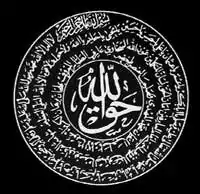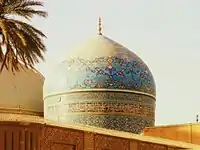Naqshbandi
The Naqshbandi (Persian: نقشبندی)[lower-alpha 1] is a major Sunni order of Sufism. Its name is derived from Baha-ud-Din Naqshband Bukhari. Naqshbandi masters trace their lineage to the Islamic prophet Muhammad through Abu Bakr, the first Caliph of Sunni Islam and Ali, the fourth Caliph of Sunni Islam.[1][2][3][4][5] It is because of this dual lineage through Ali and Abu Bakr through the 6th Imam Jafar al Sadiq that the order is also known as the "convergence of the two oceans" or "Sufi Order of Jafar al Sadiq".[6]

| Part of a series on Islam Sufism |
|---|
 |
|
|
History

The Naqshbandi order owes many insights to Yusuf Hamdani and Abdul Khaliq Gajadwani in the 12th century, the latter of whom is regarded as the organizer of the practices and is responsible for placing stress upon the purely silent invocation.[7] It was later associated with Baha-ud-Din Naqshband Bukhari in the 14th century, hence the name of the order. The name can be interpreted as "engraver (of the heart)", "pattern maker", "reformer of patterns", "image maker", or "related to the image maker". The way is sometimes referred to as "the sublime sufi path" and "the way of the golden chain."
Afterwards, a branch or sub-order name was added. From 'Ubeydullah Ahrar to Imam Rabbani, the way was called "Naqshbandiyya-Ahrariyya"; from Imam Rabbani to Shamsuddin Mazhar "Naqshbandiyya-Mujaddadiyya"; from Shamsuddin Mazhar to Khalid al-Baghdadi "Naqshbandiyya-Mazhariyya"; from Mawlana Khalid onwards "Naqshbandiyya-Khalidiyya"; "Naqshbandiyya-Mustafvi" (Khalidi) and so on.[8]
South Asia



The Naqshbandiyya order became an influential factor in Indo-Muslim life and for two centuries it was the principal spiritual order in the Indian subcontinent. Baqi Billah Berang (No. 24 in the Naqshbandi-Haqqani Golden Chain) is credited for bringing the order to India during the end of the 16th century. He was born in Kabul and brought up and educated in Kabul and Samarqand, where he came in contact with the Naqshbandiyya order through Khawaja Amkangi. When he came to India, he tried to spread his knowledge about the order, but died three years later.[9] His disciple Ahmad Sirhindi (No. 25 in the Naqshbandi-Haqqani Golden Chain) took over after his death. Later he became known as Mujaddad-i-Alf-i-Thani. It was through him that the order gained popularity within a short period of time.[9] Shah Waliullah Dehlawi was an 18th-century member of the order.
Syria
The Naqshbandiyya was introduced into Syria at the end of the 17th century by Murad Ali al-Bukhari, who was initiated in India. Later, he established himself in Damascus, but traveled throughout Arabia. His branch became known as the Muradiyya. After his death in 1720, his descendants formed the Muradi family of scholars and sheikhs who continued to head the Muradiyya. In 1820 and onward, Khalid Shahrazuri rose as the prominent Naqshbandi leader in the Ottoman world. After the death of Khalid in 1827, his order became known as the Khalidiyya, which continued to spread for at least two decades. In Syria and Lebanon, the leaders of every active Naqshbandiyya group acknowledged its spiritual lineage, which had retained the original Naqshbandiyya way. Later a strife between Khalid's khalifas led to disruption of the order, causing it to divide.[10]
When political leader Musa Bukhar died in 1973, the pre-Mujaddidi line of the Naqshbandiyya in Greater Syria came to an end. One of the only branches to have survived till recently is the one based in the khanqah al-Uzbakiyya in Jerusalem. The number of its members had increased at the end of the 19th century. The Farmadiyya branch, which practices silent and vocal invocation, is still present in Lebanon and is named after Ali-Farmadi.[10]
Egypt
During the middle of the 19th century Egypt was inhabited and controlled by Naqshbandis. A major Naqshbandi khanqah was constructed in 1851 by Abbas I, who did this as a favor to Naqshbandi sheikh Ahmad Ashiq. Ahmad Ashiq headed the order till his death in 1883. Ahmad Ashiq's was a practicer of the Diya'iyya branch of the Khalidiyya. In 1876, sheikh Juda Ibrahim amended the original Diya’iyya, which became known as al-Judiyya, and gained a following in al-Sharqiyya province in the eastern Nile Delta.[10]
During the last two decades of the 19th century two other versions of Naqshbandiyya spread in Egypt. One of these was introduced by a Sudanese, alSharif Isma'il al-Sinnari. Al-Sinnari had been initiated into the Khalidiyya and Mujaddidiyya by various sheikhs during his time in Mecca and Medina. Initially, he tried to obtain a following in Cairo but was not able to, therefore he resorted going to Sudan. It is from there that the order spread into Upper Egypt from 1870 onward under Musa Mu’awwad, who was al-Sinnari's successor. Muhaamad al-Laythi, son of al-Sinnari, was the successor after Mu’awwad's death.[10]
The Judiyya and the Khalidiyya branches spread in the last decades of the 19th century and continued to grow and are still active today. Muhammad Amin al-Kurdi led a branch until his death in the early 1900s, after his death the branch was headed by his son Najm a-Din El-Kurdi until his death in 1988 then his son; PHD.Abdelrahman El-Kurdi, the deputy dean of Al-Azhar university led the branch for 2 years but he died of cancer, after his death the branch was headed by PHD.Mohamed Deyaa Aldin El-Kurdi until his death in 2001. Now that Branch is headed by counseller/Judge Mohamed "seif" El-Kurdi. The El-Kurdi family are also part of the Islamic prophet Mohammed's Bloodline. Unfortunately, none of the early orders survived far into the 20th century. The longest living group of khanqah based Naqshbandis lived in the khanqah of sheikh Ahmad Ashiq, which closed in 1954. This is when all the khanqahs in Egypt were closed and the awqaf supporting these establishments were taken over by the Ministry of Awqaf. The buildings were either assigned a different function or demolished as part of urban renovation programs.[10]
China

Ma Laichi brought the Naqshbandi (نقشبندية) 納克什班迪 order to China, creating the Khufiyya (خفيه) 虎夫耶 Hua Si Sufi 华寺; ("Multicolored Mosque") menhuan. Ma Mingxin, also brought the Naqshbandi order, creating the Jahriyya (جهرية) 哲赫林耶 menhuan. These two menhuan were rivals, and fought against each other which led to the Jahriyya Rebellion, Dungan revolt, and Dungan Revolt (1895).[11]
Some Chinese Muslim Generals of the Ma Clique belonged to Naqshbandi Sufi menhuan including Ma Zhan'ao and Ma Anliang of the Khufiyya Naqshbandi menhuan. Ma Shaowu, and Ma Yuanzhang were other prominent leaders from the Jahriyya Naqshbandi menhuan.
Prominent sheikhs
- Baha-ud-Din Naqshband Bukhari (1318–1389), the founder of the Sufi Naqshbandi Order
- Shaykh Ahmad al-Farūqī al-Sirhindī (1564–1624), a Mujaddid and leading Naqshbandi Sheikh from India
- Shah Waliullah Dehlawi (1703–1762), a Mujaddid and a leading Naqshbandi Sheikh from India
Practices
Criteria of a sheikh

The following would always apply to genuine Sufi Naqshbandi teachers or sheikhs:
- They comply with the law.
- They must adhere to the Sunnah.
- They must be scholars. There can be no Sufism without knowledge.
- They must not engage in Bid'ah (religious innovation).
- They accept interaction with other disciples of the order.
- They do not accept personal certification of dead persons, or in dreams, or through special spiritual experience (rawhani). There are exceptions to this rule according to the uwaisi concept of transmission where someone who lived before can train and transmit knowledge to someone who came later.
- They accept written personal certification only in the presence of witnesses.
11 principal teachings

Known as the Eleven Naqshbandi principles, the first eight were formulated by Abdul Khaliq Gajadwani, and the last three were added by Baha-ud-Din Naqshband Bukhari.[7]
- Remembrance (Yād-kard – Persian: یاد کرد): Always orally and mentally repeating the dhikr.
- Restraint (Bāz-gasht – Persian: بازگشت): Engaging in the heart repetition of the al-kalimat at-tayyiba phrase – "La-ilaha il-allah muhammadur rasul-allah".
- Watchfulness (Negāh-dāsht – Persian: نگاه داشت): Being conscientious over wandering thoughts while repeating Al-kalimat at-tayyiba.
- Recollection (Yād-dāsht – Persian: ياد داشت): Concentration upon the Divine presence in a condition of dhawq, foretaste, intuitive anticipation or perceptiveness, not using external aids.
- Awareness while breathing (Housh dar dam – Persian: هوش در دم): Controlling one's breathing by not exhaling or inhaling in the forgetfulness of the Divine.
- Journeying in one's homeland (Safar dar watan - Persian: سفر در وطن): An internal journey that moves the person from having blameworthy to praiseworthy properties. This is also referred to as the vision or revelation of the hidden side of the shahada.
- Watching one's step (Nazar bar qadam - Persian: نظر بر قدم): Do not be distracted from purpose of the ultimate journey.
- Solitude in a crowd (Khalwat dar anjuman - Persian: خلوت در انجمن): Although journey is outwardly in this world, it is inwardly with God.
- Temporal pause (Wuquf-i zamāni - Persian: وقوف زمانی): Keeping account of how one spends his or her time. If time is spent rightfully give thanks and time is spent incorrectly ask for forgiveness.
- Numerical pause (Wuquf-i adadi - Persian: وقوف عددی): Checking that the dhikr has been repeated in odd numbers.
- Heart pause (Wuquf-i qalbi - Persian: وقوف قلبی): Forming a mental picture of one's heart with the name of God engraved to emphasize that the heart has no consciousness or goal other than God.
Muraqaba
Muraqaba is known as spiritual communion. In this practice one tries to unveil the mystery of life by losing oneself in it. One imagines his heartbeats calling out the name of the almighty. It is highly believed that it is true that our heart calls out for Allah with every beat. But it is our hearts which are draped by sins and so the heartbeat is heard as dhak dhak and not Allah Allah. Muraqaba is done by sitting in a lonely place with eyes closed and maintaining a calm position, imagining your exterior eyes closed, interior eyes opened, your heart calling out for Allah, and trying to hear the word 'Allah' in each and every heartbeat.
Tawajjuh
Tawajjuh is the basis of spirituality. It's the process of transferring spiritual light (Faiz) that shaykh transfers from his enlightened heart to his or her murid's (student) heart. This light leads the way to enlightenment and makes truth differentiate from false. No spirituality is possible without Tawajjuh. This is how Islamic spirituality differs from other spiritual practices. In Islamic spirituality, murid tends to be more and more in the company of his shaykh to receive Faiz through Tawajjuh that makes enlightenment an easier process as his heart day by day enlightens up to God's presence and his commands towards him and humanity. Process of Tawajjuh is like lighting a candle from another candle. The candle that lightened the other loses nothing, and the candle that got lighted, gains everything.
See also
- Army of the Men of the Naqshbandi Order
- Abobaker Mojadidi
- Akhundzada Saif-ur-Rahman Mubarak
- Ameer Muhammad Akram Awan
- Dungan Revolt (1895–96)
- Naqshbandi Lataif (Mujaddidiyya)
- Naqshbandi Lataif (Afghan Tradition)
- Llewellyn Vaughan-Lee
- Muhammad Channan Shah Nuri
- Naqshbandi Hussaini Golden Chain
- Naqshbandi Tahiri Golden Chain
- Nazim Al-Haqqani
- Sufism in India
- Ziyarat Naqshband Sahab
- Naqshbandi Haqqani Sufi Order
- Sufi Center Rabbaniyya
References
Notes
Citations
- Milani, M.; Possamai, A.; Wajdi, F. (2017). "Branding of Spiritual Authenticity and Nationalism in Transnational Sufism". In Michel, P.; Possamai, A.; Turner, B. (eds.). Religions, Nations, and Transnationalism in Multiple Modernities. Palgrave Macmillan. p. 197-220. doi:10.1057/978-1-137-58011-5_10. ISBN 978-1-137-59238-5.
- Reimer, D. (1913). Die Welt des Islams Zeitschrift der Deutschen Gesellschaft für Islamkunde. Deutsche Gesellschaft für Islamkunde. p. 191.
- Zelkina, Anna (2000). Quest for God and Freedom: Sufi Responses to the Russian Advance in the North Caucasus. C. Hurst & Co. Publishers. p. 77. ISBN 9781850653844.
Excerpt from note 11: "There are some Naqshbandi branches which trace their silsila through Ali ibn Abi Taleb." See Algar, 1972, pp. 191-3; al-Khani, 1308. pg 6
- Kugle, Scott Alan (2007). Sufis & saints' bodies: Mysticism, Corporeality and Sacred Power in Islam. University of North Carolina Press. p. 143. ISBN 978-0-8078-5789-2. Archived from the original on 3 December 2016. Retrieved 12 August 2015.
- Kabbani, Muhammad Hisham (2004). Classical Islam and the Naqshbandi Sufi Tradition. Islamic Supreme Council of America. p. 557. ISBN 1-930409-23-0.
- Ziad, Waleed (2018). "From Yarkand to Sindh via Kabul: The Rise of Naqshbandi-Mujaddidi Sufi Networks in the Eighteenth and Nineteenth Centuries". The Persianate World: Rethinking a Shared Sphere. Brill. p. 165. doi:10.1163/9789004387287_007. ISBN 9789004387287. S2CID 197951160.
- Trimingham, J. Spencer (1998). "The Chief Tariqa Lines". The Sufi Orders in Islam. Oxford University Press. p. 31. ISBN 9780198028239.
- Eraydın, Selçuk (2001). Tasavvuf ve Tarikatlar (in Turkish). Marmara Üniversitesi Ilahiyat Vakfi Yayinlari. p. 434. ISBN 9789755480503.
- Haq, Muhammad M. (1985). Some Aspects of the Principle Sufi Orders in India. Islamic Foundation. Bangladesh. p. 20.
- De Jong, Frederick (2000). Sufi Orders in Ottoman and Post-Ottoman Egypt and the Middle East: Collected Studies. Isis Press. Vol. 48, Analecta Isisiana. ISBN 9789754281781.
- Kees Versteegh; Mushira Eid (2005). Encyclopedia of Arabic Language and Linguistics: A-Ed. Brill. p. 380]. ISBN 978-90-04-14473-6. Archived from the original on 3 December 2016. Retrieved 24 January 2016.
Further reading
- Algar, Hamid (1998). Sufism: Principles and Practice. Islamic Publications International. ISBN 1-889999-02-4.
- Bennett, John G. (1995). The Masters of Wisdom. Bennett Books. ISBN 1-881408-01-9.
- Clayer, Nathalie, Muslim Brotherhood Networks, European History Online, Mainz: Institute of European History, 2011, retrieved: 23 May 2011.
- Itzchak Weismann (2007). The Naqshbandiyya: Orthodoxy and Activism in a Worldwide Sufi Tradition. Routledge. ISBN 978-0-415-32243-0.
- Sheikh Hisham Kabbani (1995). The Naqshbandi Sufi Way History and Guidebook of the Saints of the Golden Chain. [kaza publications inc]. ISBN 9780934905343.
- Sufism in Central Asia A Force for Moderation or a Cause of Politicization? By Martha Brill Olcott.
